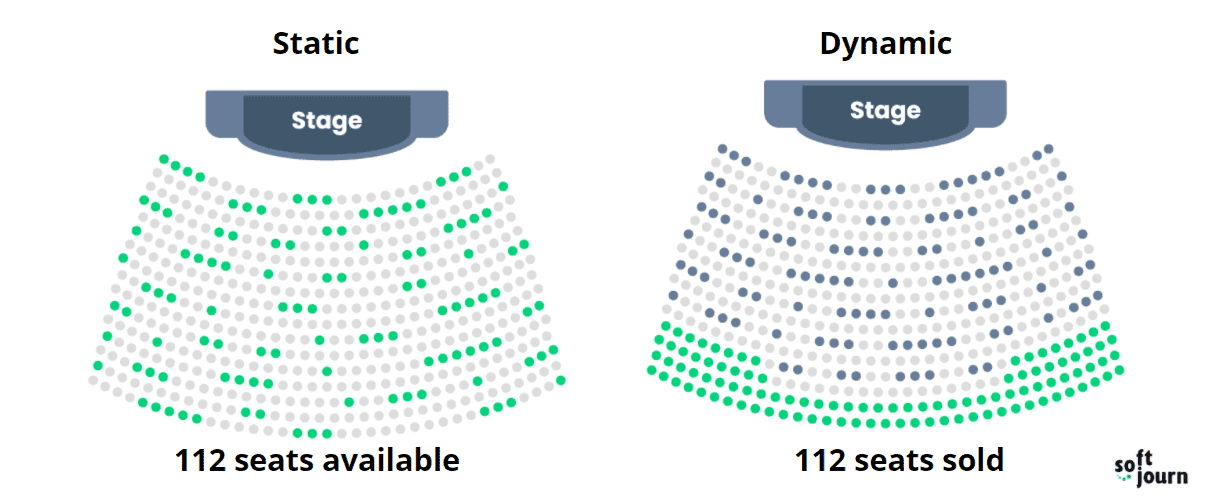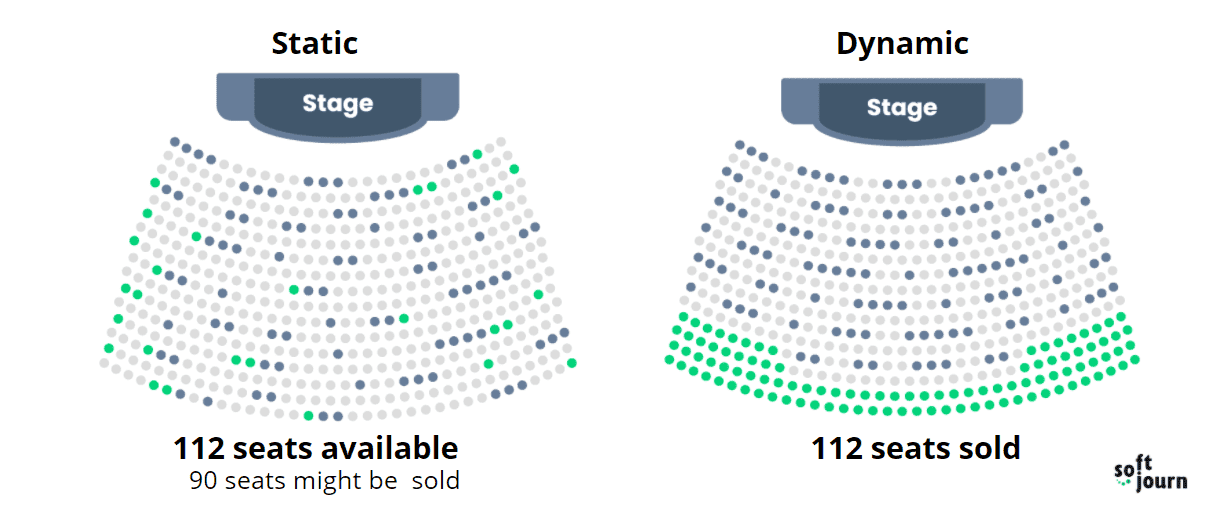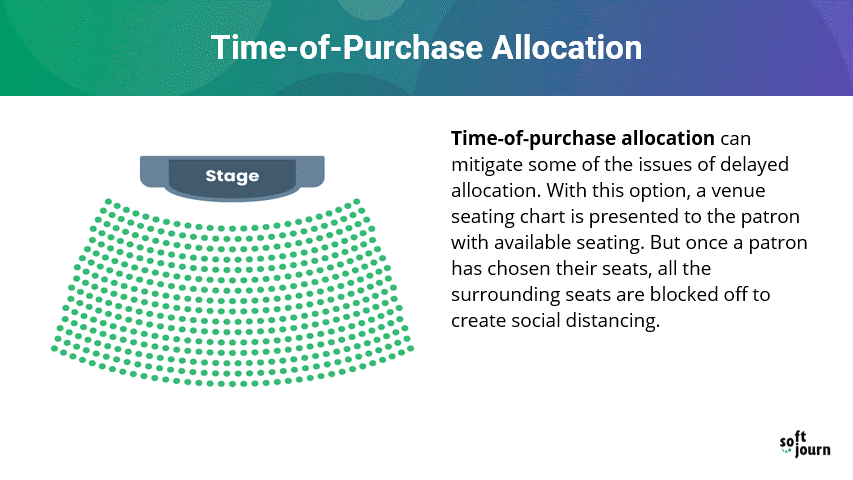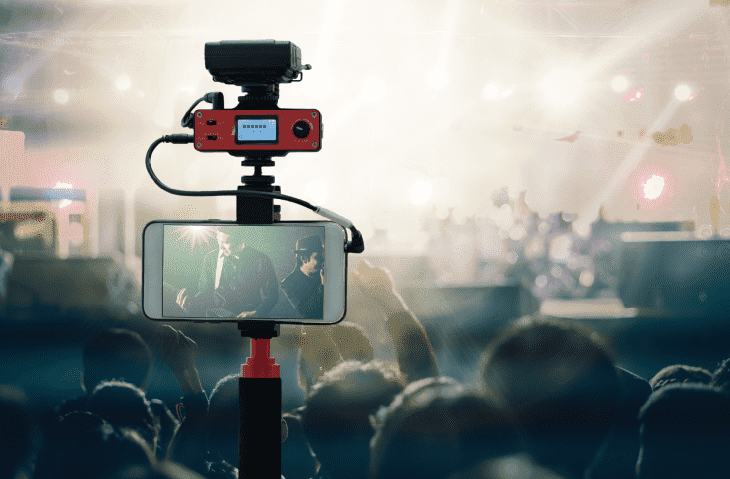Please accept cookies to access this content
Is social distancing the key to in-person event planning?
The short answer is, no, it’s not a silver bullet, but it is an important part of developing a safe event that draws audiences back to venues. Social distancing’s impact on ticket inventory can hinder as much as help in organizing post-pandemic live events. Plus there are other areas to consider besides capacity and sales, such as access control.
Softjourn’s CTO Jeff Kreuser and Ticketing Expert Lyubomyr Nykyforuk discuss different social distancing algorithms for venue mapping tools, how they affect event planning, and additional considerations that can go into post-pandemic event planning.
Softjourn (SJ): Jeff, how many kinds of social distancing algorithms are there?
Jeff Kreuser (JK): With social distancing for venue seating, there’s a couple different social distancing algorithms currently being used. The two most popular are predefined venue seating, and the second is dynamic seat allocation.
There are two ways you can do dynamic seating allocation: one is with delayed seat allocation and the other is at time of purchase.
SJ: How does predefined venue seating work?
JK: With predefined venue seating, there are a few types of inputs you can use to determine how many seats that you can or should have.
The first input can be a restriction, such as local regulations restricting the number of seats. For example, they may say you can only be at 20% capacity.
Another input is historical data. This allows you to try to determine how many seat groupings you need, such as numbers of twos, threes, fours, etc. Historical data can be taken from different areas and include things like type of event, (sporting, theater, etc.), time of year, time of day, or other factors.
You can then drill down: if it’s, say, a theater event, is it a drama, musical, or live comedy? Each of those event types will have some statistical data you can use to determine what kind of ticket purchases and groupings can or should be made. Time of day, such as a matinee on a Sunday afternoon versus a weekday evening, will also have different clientele and thus a different type of seat grouping.
SJ: How does predefined venue seating work with social distancing?
JK: Most of the time, social distancing regulations are in feet. Patrons and event staff need to stay six feet apart or more, or 10 feet, or whatever the local regulation is.
The issue for venues is that seating isn’t allocated by feet – you have rows, and seats within a row. Instead, you have to determine how many rows or seats are required to meet the minimum distance.

A predefined venue seating chart can be created using different kinds of input, such as a restriction or historical data.
In our scenario here, you can see that we have a capacity of 488 with a utilization of 23%. That gives us about 112 actual seats available. Our scenario shows single seats through groups of up to six. That keeps a minimum social distance of a row and at least two seats between groups.
SJ: What are some of the pros and cons of using a predefined seating chart?
JK: One of the biggest pros is that it is easy to implement. You measure your seats, and you calculate what can fit within social distancing regulations. You don’t have to use historical data if you don’t want to. You can instead decide to just do, say, all groupings of two. Maybe you mix in some groupings of four. If you do use some historical data, you can refine the number of groupings depending on the event and other details.
But there’s definitely some cons to this method. One is that if you are not limited on capacity, you are probably going to see a lower utilization compared to the time of purchase method. What can happen with a predefined seating chart method is, say I have groupings of twos and fours set up. I sell out on my twos. Then only the groupings of four are left when a couple wants to purchase seats. I can try to do something different and move seats around. Or I can force those patrons to buy all four seats for only two people. Or I can sell two seats and let the other two go because with social distance rules I can’t sell those. All these scenarios can be a problem.
This can also create some patron dissatisfaction. If you want to see the show and I only have a grouping of four seats, you must buy all four. If your group is only two people, that presents a problem. Most people would likely pass on needing to buy all four seats. Another perspective is if the group is four people, but you only have twos left, that group will have to split up. It’s not an optimal patron experience.

Ticketing platforms and event organizers considering a predefined venue seating chart as their social distancing algorithm should note the pros and cons.
SJ: Lyubomyr, can you tell us about dynamic allocation and social distancing?
Lyubomyr Nykyforuk (LN): As Jeff mentioned, we can name two types of dynamic seat allocations: delayed and time of purchase. Let’s start with delayed.
With delayed allocation, the idea is to delay seat distribution to as close to the event day as possible. This gives event organizers detailed information about patron groups coming to the event. Like what airlines do because you may not know your seat until the check-in time. In this case, the event organizer would have to manually assign seats, which can be time consuming if the ticketing service doesn’t provide an automation tool.
Several criteria can be considered during the seat allocation process, such as:
- Date and time of order purchase;
- Patrons who purchase tickets earlier get better seats;
- Giving best seats to membership holders or VIP patrons;
- Or the size of the group, among other factors.

Ticketing platforms and event organizers considering delayed dynamic seats allocation as their social distancing algorithm should note the pros and cons.
SJ: What are the pros and cons of delayed dynamic seat allocation?
LN: One pro is that this option provides better capacity utilization compared to static methods like a predefined seating chart. We don’t need to guess who is coming to the event.
One con, however, is that the ticketing system must change the ticket sales process to not automatically assign seats. This can cause patron frustration because patrons won’t know where they are sitting when they buy their tickets.
The ticketing system also needs to provide tools for seat allocation. Distributing seats manually can be very time consuming. Moreover, there could be a risk of selling more seats that can be accommodated due to social distancing rules.

Ticketing platforms and event organizers considering delayed dynamic seats allocation as their social distancing algorithm should note the pros and cons.
SJ: What about time-of-purchase allocation?
LN: Time-of-purchase allocation can mitigate some of the issues of delayed allocation. With this option, a venue seating chart is presented to the patron with available seating. But once a patron has chosen their seats, all surrounding seats are blocked off to create social distancing.
A time of purchase allocation social distancing algorithm allows patrons to choose their own seats, and then blocks off surrounding seats to create social distancing.
This can be achieved using a best-available algorithm, or making some changes to the pick-your-own seat system. Different options can be applied to create social distancing. The most common are the number of rows in front of and behind the selected seats, as well as the number of seats on the left and right. Those seats become unavailable for the next patrons buying tickets.
SJ: What are the pros and cons of a time-of-purchase allocation algorithm?
LN: We can have better capacity utilization because seats are booked upon patron request. This also provides a good user experience because patrons know where they will sit and there is no need for event organizer staff involvement in seating arrangement.
To achieve this, however, the ticketing system must adopt a technology change in their pick-your-own-seats system or best-available algorithm functions.

Static vs. Dynamic Seats Allocation Image 1. Two venue seating charts show how static and dynamic social distancing algorithms might affect patron purchasing behavior.
LN: Here’s a side-by-side visualization of static versus dynamic methods (Dynamic vs. Static Seats Allocation Image 1). As we can see with an equal number of seats on each side, we have more inventory remaining on the right due to more efficient capacity utilization. This assumes that all green seats defined on the left will be sold.

Static vs. Dynamic Seats Allocation Image 2. In this image, the time of purchase allocation social distancing algorithm allows for a more efficient sale of available inventory.
Chances are some seats will not be purchased, or only partially purchased if the ticketing system allows that. The real difference may be even bigger like we see in Image 2. Not all of the green seats on the left side were purchased and will cause additional revenue loss for the event organizer.

Ticketing platforms and event organizers considering time-of-purchase allocation as their social distancing algorithm should note the pros and cons.
SJ: What else is important to consider when adding social distancing to a venue and planning a live, in-person event?
JK: There are many different areas to consider; both in what you must account for, and what can be impacted by social distancing.
Entry can be severely impacted by social distancing regulations; how you implement access control is important. One method that’s been popular is timed entry/exit. While it is useful for entry, for dispersing crowds (i.e. exiting) this is much harder and needs to be monitored to mitigate groupings.
Pedestals are being used more often for contactless entry. Ticketing platforms and event organizers have also pivoted to virtual hybrid events, which can improve revenue by offering a streaming or digital aspect to an event.
Some events are doing patron screening during checkout, where patrons report any symptoms they’ve experienced within a certain period. Sometimes these screens are also done a few hours in advance of an event, to provide additional assurance that all patrons within a venue or building aren’t expressing symptoms.
Notifying patrons about health screenings can be part of a successful communications plan that keeps everyone in the loop and reassured that their safety is being taken seriously.
Contact tracing can also be helpful, because it shows patrons that even if something were to be discovered after the event, they’ll be contacted with any necessary follow up information or instructions. Communicating with patrons often and well increases the likelihood of their return to events, and impresses upon them that their safety and comfort is paramount.
Contactless food ordering and in-seat delivery is becoming more widespread. This too can make patrons feel comfortable again, as well as enhance the in-venue patron experience.
Some ticketing platforms and venues are considering digital wallets that can store vaccination records. If a patron has received a vaccination, they can show that information as part of their entry process or even as part of a ticket purchase earlier on.
Security is also immensely important. It will vary depending on event type, what kind of event organizer is holding the event (for example, volunteer staff vs. commercial, both of which have access to very different resources).
And the most important question, how will social distancing enforcement work and still keep everyone safe?















